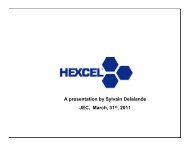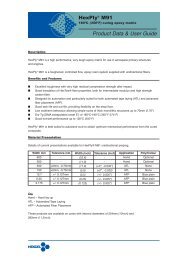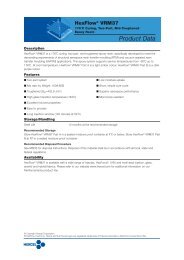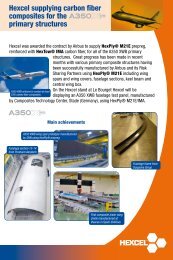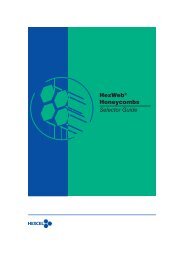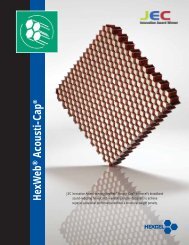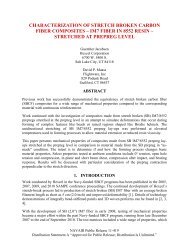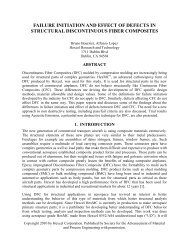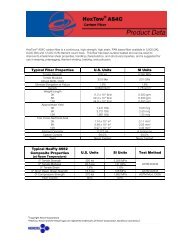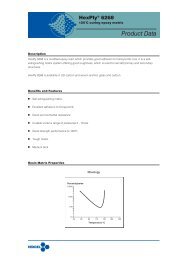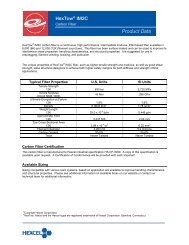UD Prepregs for Load Carrying Structures in Infused - Hexcel.com
UD Prepregs for Load Carrying Structures in Infused - Hexcel.com
UD Prepregs for Load Carrying Structures in Infused - Hexcel.com
You also want an ePaper? Increase the reach of your titles
YUMPU automatically turns print PDFs into web optimized ePapers that Google loves.
0<br />
Sandia 210710
<strong>UD</strong> <strong>Prepregs</strong> <strong>for</strong> <strong>Load</strong> <strong>Carry<strong>in</strong>g</strong> <strong>Structures</strong><br />
<strong>in</strong> <strong>Infused</strong> Blades<br />
A presentation by Dr Chris Shennan<br />
R&T Manager<br />
<strong>Hexcel</strong> Corporation
Agenda<br />
2<br />
�Introduction to <strong>Hexcel</strong> <strong>in</strong> W<strong>in</strong>d Energy<br />
�Prepreg and <strong>in</strong>fusion technologies<br />
�Comb<strong>in</strong>ations of prepreg and <strong>in</strong>fusion<br />
�Examples<br />
� <strong>Prepregs</strong> <strong>in</strong> thick lam<strong>in</strong>ates<br />
� Comparison of mechanical properties from prepreg and <strong>in</strong>fusion<br />
� Case study – large scale trial<br />
�Conclusions<br />
Sandia 210710
Introduction to <strong>Hexcel</strong> <strong>in</strong> W<strong>in</strong>d Energy
<strong>Hexcel</strong>: Company Profile<br />
4<br />
�Lead<strong>in</strong>g global provider of advanced <strong>com</strong>posites<br />
�Primary markets: aerospace, defence and w<strong>in</strong>d energy<br />
�Net Sales of $1.108 billion <strong>in</strong> 2009<br />
�4,000 employees worldwide<br />
�Headquarters <strong>in</strong> Stam<strong>for</strong>d, CT, USA<br />
�Listed on NYSE<br />
�Manufactur<strong>in</strong>g <strong>in</strong> n<strong>in</strong>e countries, 18 locations<br />
Sandia 210710
<strong>Hexcel</strong> - Vertically Integrated<br />
5<br />
Sandia 210710
<strong>Hexcel</strong> <strong>in</strong> Global W<strong>in</strong>d Energy<br />
6<br />
� Market Leader <strong>for</strong> prepreg materials <strong>in</strong> W<strong>in</strong>d Energy<br />
� More than 65000 tons of prepreg products supplied s<strong>in</strong>ce early 1990s<br />
� Global Supply, Sales, Technical Support and R&T<br />
� Product development <strong>in</strong> close cooperation with key accounts<br />
Sandia 210710<br />
New plant <strong>for</strong> w<strong>in</strong>d energy at W<strong>in</strong>dsor<br />
Colorado 2009
Infusion and Prepreg Technologies<br />
What are prepregs?<br />
How do prepreg and <strong>in</strong>fusion processes <strong>com</strong>pare?
Impregnation of Fibre and Fabrics from Res<strong>in</strong><br />
8<br />
Sandia 210710<br />
Prepreg production is<br />
now highly <strong>in</strong>dustrialised<br />
<strong>for</strong> optimum cost and quality
Typical Prepreg Systems <strong>in</strong> W<strong>in</strong>d Energy<br />
9<br />
�Res<strong>in</strong> systems<br />
M9 290 J/g<br />
M9F 250 J/g<br />
M19 190 J/g<br />
�Product <strong>for</strong>ms (<strong>UD</strong>)<br />
Carbon 500-600 gsm<br />
Glass 1000-3000 gsm<br />
�Cure cycles (ramps, dwells + cure times)<br />
~4 (M19) to ~8 (M9) hours when optimised<br />
�Storage at +5 o C (6 month shelf life)<br />
Typical prepregs <strong>com</strong>b<strong>in</strong>e high areal weights,<br />
full impregnation, and low reaction enthalpies<br />
Sandia 210710
Prepreg and Infusion <strong>in</strong> W<strong>in</strong>d Energy<br />
10<br />
Infusion (epoxy)<br />
Worldwide Cumulative MW Installed<br />
160 000 total (2009)<br />
49%<br />
14%<br />
Sandia 210710<br />
37%<br />
Prepreg epoxy Infusion epoxy Infusion PE/VE<br />
The split between prepreg and <strong>in</strong>fusion <strong>for</strong> blade<br />
manufacture is similar<br />
Prepreg (epoxy)
Blade technology: Infusion versus Prepreg<br />
11<br />
Raw Material Cost ~ 3.0 (res<strong>in</strong> + glass NCF)<br />
€/kg<br />
€/m 3<br />
Infusion Prepreg<br />
Foam: 1600<br />
+<br />
Both technologies have their pros and cons<br />
Sandia 210710<br />
<strong>UD</strong>: 2.8 to 3.3/ Glass NCF ~ 4.0<br />
Foam: 1800<br />
-<br />
Tool<strong>in</strong>g Cost ++ --<br />
Capex Requirements + -<br />
Layup - +<br />
Cure Cycle - +<br />
Up to 20 hours Up to 10 hours<br />
Blade F<strong>in</strong>ish<strong>in</strong>g + -<br />
Health & Safety - +<br />
Waste & Scrap -- -<br />
Throughput & Quality Control -- ++<br />
Mechanical Per<strong>for</strong>mance - +
12<br />
Why not <strong>com</strong>b<strong>in</strong>e Prepreg and Infusion<br />
Technologies?
Comb<strong>in</strong>ations of Prepreg and Infusion Technologies<br />
13<br />
Proposal<br />
Use prepreg <strong>in</strong> load critical structures (spar caps or girders)<br />
Benefits<br />
Full impregnation (even <strong>in</strong> thickest structures, even with carbon)<br />
Choice of chemistry (reaction enthalpy) to suit cycle<br />
Low exotherm<br />
Benefits (to be demonstrated)<br />
Low porosity <strong>in</strong> lam<strong>in</strong>ate<br />
Fast cure cycle<br />
Maximum mechanical properties from pure <strong>UD</strong><br />
Sandia 210710
Comb<strong>in</strong>ations of Prepreg and Infusion Technologies<br />
14<br />
Three examples<br />
1. <strong>Prepregs</strong> <strong>in</strong> thick lam<strong>in</strong>ates<br />
2. Comparison of mechanical properties from prepreg and<br />
<strong>in</strong>fusion<br />
3. Case Study: Large scale trial of prepreg <strong>in</strong> a spar cap<br />
Sandia 210710
<strong>Prepregs</strong> <strong>in</strong> Thick Lam<strong>in</strong>ates<br />
Example 1
Cure Cycles Us<strong>in</strong>g Low Exotherm <strong>Prepregs</strong><br />
16<br />
5 plies<br />
Dry BB450<br />
60 prepreg plies<br />
11 biax layers<br />
~ 6 cm thick<br />
Sandia 210710<br />
M(1)9.1/32%/1200/G<br />
X 10
Top<br />
Middle<br />
Bottom<br />
Cure Cycles: Layup Configuration<br />
17<br />
Thermocouples<br />
Left Middle Right<br />
After cure<br />
Sandia 210710<br />
Vacuum bag<br />
Per<strong>for</strong>ated<br />
film (P3)<br />
Bleeder (2 plies)<br />
Peel ply<br />
Prepreg stack
Cure Cycles: Results<br />
18<br />
M9.1 M19.1<br />
Maximum temperature (°C)<br />
Tool surface<br />
In the middle<br />
125<br />
166<br />
112<br />
138<br />
Exotherm after (hours)<br />
4 6<br />
M19.1<br />
Sandia 210710<br />
Peak exotherm can be reduced<br />
by optimisation of<br />
matrix and cure cycle<br />
Cure cycles<br />
not optimised
Low Porosity <strong>in</strong> Thick Lam<strong>in</strong>ates<br />
19<br />
4 plies<br />
9 plies<br />
53 prepreg plies<br />
6 biax layers<br />
~ 6 cm thick<br />
Sandia 210710<br />
X 5<br />
Dry BB600<br />
M9.6F/32%/1600+CV/G
Low Porosity: Results<br />
20<br />
Fiber<br />
volume (%)<br />
Air content<br />
(%)<br />
51,9 0,2<br />
Very low porosities can be<br />
achieved with standard prepregs<br />
even <strong>in</strong> thick lam<strong>in</strong>ates<br />
Sandia 210710
Comparison of Mechanical Properties<br />
from Prepreg and Infusion<br />
Example 2
Mechanical Evaluation - Overview<br />
22<br />
Prepreg panel cured at 100°C<br />
Mechanical <strong>com</strong>parison<br />
Infusion panel cured at 100°C<br />
Sandia 210710<br />
Reference prepreg panel cured<br />
at 120°C under pressure<br />
(gives ultimate per<strong>for</strong>mance)<br />
Test Plies<br />
Tensile 0° 2<br />
Tensile 90°<br />
Compression 0° 2<br />
2<br />
4<br />
ILSS/ SBS 4<br />
IPS 2
Mechanical Evaluation - Trial Layup<br />
23<br />
Top view<br />
Side view<br />
4 Plies 2 Plies 2 Plies<br />
1300 mm 1700 mm 1000 mm<br />
TC Air temp<br />
Sandia 210710<br />
1000 mm<br />
0°<br />
90°<br />
TC
Mechanical Evaluation - Trials<br />
24<br />
Infusion:<br />
� Re<strong>in</strong><strong>for</strong>cement: LT1218 (stitched <strong>UD</strong>)<br />
� Res<strong>in</strong>: Hexion RIM 135<br />
Prepreg:<br />
� M9.1/32%/1200/G<br />
Res<strong>in</strong> flow<br />
Res<strong>in</strong> <strong>in</strong>let Res<strong>in</strong> outlet<br />
Flow medium Per<strong>for</strong>ated film: P1<br />
Peel ply<br />
Bleeder<br />
Peel ply<br />
Sandia 210710<br />
VAP Membrane<br />
Dry fabric<br />
Per<strong>for</strong>ated film: P3<br />
Prepreg and <strong>in</strong>fusion panels given the same cure of 6 hours at 100 o C
Mechanical Evaluation – Reference<br />
25<br />
� M9.1/32%/1200/G<br />
� 8 bars<br />
� Cure cycle:<br />
140<br />
120<br />
100<br />
80<br />
60<br />
40<br />
20<br />
0<br />
00:00:00<br />
00:25:00<br />
00:50:00<br />
01:15:00<br />
01:40:00<br />
02:05:00<br />
02:30:00<br />
Def<strong>in</strong>es ultimate per<strong>for</strong>mance of prepreg<br />
02:55:00<br />
03:20:00<br />
03:45:00<br />
Sandia 210710<br />
04:10:00<br />
04:35:00<br />
05:00:00<br />
05:25:00<br />
05:50:00
Mechanical Evaluation: Results<br />
Panel<br />
Characterisation:<br />
Mechanical results:<br />
26<br />
* normalised to FV=60%<br />
Reference Prepreg Infusion<br />
Fiber volume (%) 70,1 65,3 58,9<br />
Air volume (%) 0 1.55 1.45<br />
Tg (DSC) (°C) 127,1 124,8 74,2<br />
Test<br />
Standard test<br />
method<br />
Plies<br />
Prepreg reference<br />
Strength (MPa) Modulus (GPa)<br />
Prepreg<br />
Strength (MPa) Modulus (GPa)<br />
Infusion<br />
Strength (MPa) Modulus (GPa)<br />
Tensile 0° *<br />
Tensile 90°<br />
EN ISO 527<br />
2<br />
2<br />
1241<br />
48<br />
48.7<br />
16.9<br />
1109<br />
28.93<br />
47.7<br />
14.29<br />
979<br />
47.75<br />
46<br />
12.61<br />
Compression 0° * ISO 14126 2 1144 51.8 771.3 45.35 657.3 49.73<br />
ILSS/ SBS ISO 14130 4 75.3 53.4 51.7<br />
Flexural 0° * ISO 14125 4 1557 42.7 1315 37.7 1131 33.2<br />
IPS EN 6031 2 45.1 6.4 36.5 4.8 43.2 3.5<br />
Sandia 210710<br />
100MPa= 14.5ksi
Mechanical Evaluation: Results<br />
27<br />
Strength MPa<br />
1800<br />
1600<br />
1400<br />
1200<br />
1000<br />
800<br />
600<br />
400<br />
200<br />
0<br />
Prepreg consistently delivers<br />
superior mechanical per<strong>for</strong>mance<br />
Tensile Compression ILSS/ SBS Flexural<br />
Sandia 210710<br />
Prepreg Reference<br />
Prepreg 100C<br />
Infusion 100C
Case Study<br />
Large Scale Trial of Prepreg <strong>in</strong> a Spar Cap<br />
Example 3
Use of Prepreg <strong>for</strong> Spar Cap Construction<br />
29<br />
Sandia 210710<br />
Pre-cured spar cap <strong>in</strong>fused to <strong>for</strong>m<br />
the <strong>com</strong>plete shell
Case Study: Carbon Girder at Half Scale<br />
30<br />
Carbon spar caplength 25 m<br />
Carbon spar cap width 0,40 m<br />
Carbon spar cap thickness 22 mm<br />
Number of plies 43<br />
Material M9.6/32%/500 + 8P/C<br />
AC controlled shelter<br />
25°C<br />
40 % HR<br />
Heated and<br />
regulated<br />
mould<br />
Peel ply<br />
<strong>UD</strong> carbon prepreg<br />
<strong>UD</strong> prepregs are ideally<br />
suited to automated layup<br />
Sandia 210710<br />
Mould temp<br />
Exotherm peak 105°C<br />
Lam<strong>in</strong>ate<br />
temperature
Case Study: Results<br />
Spar cap Tg 106°C<br />
Average porosity 0,24 %<br />
Highest porosity value 0,8 % (1 po<strong>in</strong>t out of 135)<br />
Lowest porosity value 0 % ( 19 po<strong>in</strong>ts out of 135)<br />
Res<strong>in</strong> content 30 %<br />
31<br />
porosity level 0,27 %<br />
Typical cross section of<br />
cured lam<strong>in</strong>ate<br />
Sandia 210710<br />
Cohesive break<br />
Good adhesion of <strong>in</strong>fused glass<br />
on prepreg carbon lam<strong>in</strong>ate
Conclusions<br />
32<br />
�Typical prepregs <strong>in</strong> w<strong>in</strong>d energy <strong>com</strong>b<strong>in</strong>e high areal weights, full<br />
impregnation and low enthalpy<br />
�These result <strong>in</strong> the follow<strong>in</strong>g:<br />
� Fast lay down of heavy weight structures, ideally suited to<br />
automation<br />
� Reliable low porosity, even <strong>in</strong> thick lam<strong>in</strong>ates<br />
� Short cure cycles<br />
�The same is true of both carbon and glass<br />
�Typical <strong>UD</strong> prepregs can have significantly higher mechanical<br />
properties than their <strong>in</strong>fused equivalents<br />
The use of <strong>UD</strong> prepregs <strong>in</strong> load bear<strong>in</strong>g structures enhances<br />
mechanical properties, reliability and productivity<br />
Sandia 210710




